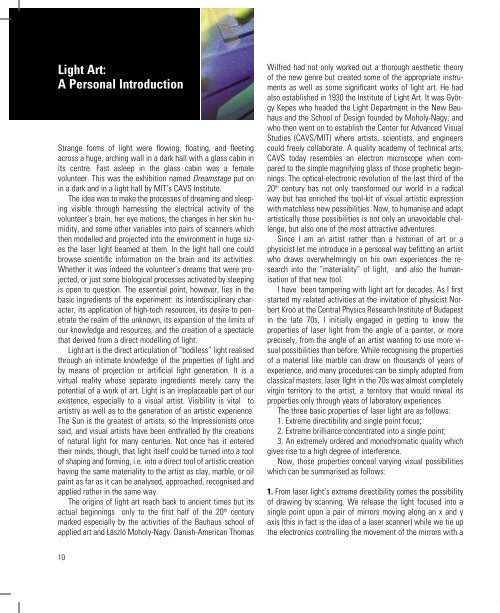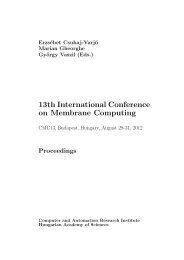Time on the Tilt
Time on the Tilt
Time on the Tilt
Create successful ePaper yourself
Turn your PDF publications into a flip-book with our unique Google optimized e-Paper software.
Light Art:<br />
A Pers<strong>on</strong>al Introducti<strong>on</strong><br />
Strange forms of light were flowing, floating, and fleeting<br />
across a huge, arching wall in a dark hall with a glass cabin in<br />
its centre. Fast asleep in <strong>the</strong> glass cabin was a female<br />
volunteer. This was <strong>the</strong> exhibiti<strong>on</strong> named Dreamstage put <strong>on</strong><br />
in a dark and in a light hall by MIT’s CAVS Institute.<br />
The idea was to make <strong>the</strong> processes of dreaming and sleeping<br />
visible through harnessing <strong>the</strong> electrical activity of <strong>the</strong><br />
volunteer’s brain, her eye moti<strong>on</strong>s, <strong>the</strong> changes in her skin humidity,<br />
and some o<strong>the</strong>r variables into pairs of scanners which<br />
<strong>the</strong>n modelled and projected into <strong>the</strong> envir<strong>on</strong>ment in huge sizes<br />
<strong>the</strong> laser light beamed at <strong>the</strong>m. In <strong>the</strong> light hall <strong>on</strong>e could<br />
browse scientific informati<strong>on</strong> <strong>on</strong> <strong>the</strong> brain and its activities.<br />
Whe<strong>the</strong>r it was indeed <strong>the</strong> volunteer’s dreams that were projected,<br />
or just some biological processes activated by sleeping<br />
is open to questi<strong>on</strong>. The essential point, however, lies in <strong>the</strong><br />
basic ingredients of <strong>the</strong> experiment: its interdisciplinary character,<br />
its applicati<strong>on</strong> of high-tech resources, its desire to penetrate<br />
<strong>the</strong> realm of <strong>the</strong> unknown, its expansi<strong>on</strong> of <strong>the</strong> limits of<br />
our knowledge and resources, and <strong>the</strong> creati<strong>on</strong> of a spectacle<br />
that derived from a direct modelling of light.<br />
Light art is <strong>the</strong> direct articulati<strong>on</strong> of “bodiless” light realised<br />
through an intimate knowledge of <strong>the</strong> properties of light and<br />
by means of projecti<strong>on</strong> or artificial light generati<strong>on</strong>. It is a<br />
virtual reality whose separate ingredients merely carry <strong>the</strong><br />
potential of a work of art. Light is an irreplaceable part of our<br />
existence, especially to a visual artist. Visibility is vital to<br />
artistry as well as to <strong>the</strong> generati<strong>on</strong> of an artistic experience.<br />
The Sun is <strong>the</strong> greatest of artists, so <strong>the</strong> Impressi<strong>on</strong>ists <strong>on</strong>ce<br />
said, and visual artists have been enthralled by <strong>the</strong> creati<strong>on</strong>s<br />
of natural light for many centuries. Not <strong>on</strong>ce has it entered<br />
<strong>the</strong>ir minds, though, that light itself could be turned into a tool<br />
of shaping and forming, i.e. into a direct tool of artistic creati<strong>on</strong><br />
having <strong>the</strong> same materiality to <strong>the</strong> artist as clay, marble, or oil<br />
paint as far as it can be analysed, approached, recognised and<br />
applied ra<strong>the</strong>r in <strong>the</strong> same way.<br />
The origins of light art reach back to ancient times but its<br />
actual beginnings <strong>on</strong>ly to <strong>the</strong> first half of <strong>the</strong> 20 th century<br />
marked especially by <strong>the</strong> activities of <strong>the</strong> Bauhaus school of<br />
applied art and László Moholy-Nagy. Danish-American Thomas<br />
Wilfred had not <strong>on</strong>ly worked out a thorough aes<strong>the</strong>tic <strong>the</strong>ory<br />
of <strong>the</strong> new genre but created some of <strong>the</strong> appropriate instruments<br />
as well as some significant works of light art. He had<br />
also established in 1930 <strong>the</strong> Institute of Light Art. It was György<br />
Kepes who headed <strong>the</strong> Light Department in <strong>the</strong> New Bauhaus<br />
and <strong>the</strong> School of Design founded by Moholy-Nagy, and<br />
who <strong>the</strong>n went <strong>on</strong> to establish <strong>the</strong> Center for Advanced Visual<br />
Studies (CAVS/MIT) where artists, scientists, and engineers<br />
could freely collaborate. A quality academy of technical arts,<br />
CAVS today resembles an electr<strong>on</strong> microscope when compared<br />
to <strong>the</strong> simple magnifying glass of those prophetic beginnings.<br />
The optical-electr<strong>on</strong>ic revoluti<strong>on</strong> of <strong>the</strong> last third of <strong>the</strong><br />
20 th century has not <strong>on</strong>ly transformed our world in a radical<br />
way but has enriched <strong>the</strong> tool-kit of visual artistic expressi<strong>on</strong><br />
with matchless new possibilities. Now, to humanise and adapt<br />
artistically those possibilities is not <strong>on</strong>ly an unavoidable challenge,<br />
but also <strong>on</strong>e of <strong>the</strong> most attractive adventures.<br />
Since I am an artist ra<strong>the</strong>r than a historian of art or a<br />
physicist let me introduce in a pers<strong>on</strong>al way befitting an artist<br />
who draws overwhelmingly <strong>on</strong> his own experiences <strong>the</strong> research<br />
into <strong>the</strong> “materiality” of light, and also <strong>the</strong> humanisati<strong>on</strong><br />
of that new tool.<br />
I have been tampering with light art for decades. As I first<br />
started my related activities at <strong>the</strong> invitati<strong>on</strong> of physicist Norbert<br />
Kroó at <strong>the</strong> Central Physics Research Institute of Budapest<br />
in <strong>the</strong> late 70s, I initially engaged in getting to know <strong>the</strong><br />
properties of laser light from <strong>the</strong> angle of a painter, or more<br />
precisely, from <strong>the</strong> angle of an artist wanting to use more visual<br />
possibilities than before. While recognising <strong>the</strong> properties<br />
of a material like marble can draw <strong>on</strong> thousands of years of<br />
experience, and many procedures can be simply adopted from<br />
classical masters, laser light in <strong>the</strong> 70s was almost completely<br />
virgin territory to <strong>the</strong> artist, a territory that would reveal its<br />
properties <strong>on</strong>ly through years of laboratory experiences.<br />
The three basic properties of laser light are as follows:<br />
1. Extreme directibility and single point focus;<br />
2. Extreme brilliance c<strong>on</strong>centrated into a single point;<br />
3. An extremely ordered and m<strong>on</strong>ochromatic quality which<br />
gives rise to a high degree of interference.<br />
Now, those properties c<strong>on</strong>ceal varying visual possibilities<br />
which can be summarised as follows:<br />
1. From laser light’s extreme directibility comes <strong>the</strong> possibility<br />
of drawing by scanning. We release <strong>the</strong> light focused into a<br />
single point up<strong>on</strong> a pair of mirrors moving al<strong>on</strong>g an x and y<br />
axis (this in fact is <strong>the</strong> idea of a laser scanner) while we tie up<br />
<strong>the</strong> electr<strong>on</strong>ics c<strong>on</strong>trolling <strong>the</strong> movement of <strong>the</strong> mirrors with a<br />
computer. The drawings scanned into <strong>the</strong> computer can thus be<br />
projected with <strong>the</strong> necessary modificati<strong>on</strong>s. Since <strong>the</strong> drawings<br />
projected have no depth of focus, <strong>the</strong>y remain in perfect focus in<br />
each sector of space. By fur<strong>the</strong>r influencing <strong>the</strong> speed, <strong>the</strong> size,<br />
<strong>the</strong> anamorphic quality, or <strong>the</strong> brilliance of <strong>the</strong> drawings projected,<br />
we may gain drawings that evolve from a single point in<br />
fr<strong>on</strong>t of our very eyes in varying sizes and animati<strong>on</strong>s. In fact,<br />
with a laser brilliant enough we can even arrive at cityscape projecti<strong>on</strong><br />
sizes. In 2005, Los Angeles-based light artist Hiro<br />
Yagamata re-drew by means of laser scanners <strong>the</strong> huge Buddha<br />
limest<strong>on</strong>e statue destroyed by <strong>the</strong> Taliban in a cliff-cavity of<br />
Bamiyan Valley, Afghanistan in its original size..<br />
Earlier this year I used an entirely different approach and resources<br />
to create two laser envir<strong>on</strong>ments mainly based <strong>on</strong> scanning<br />
in <strong>the</strong> Kiscelli Museum of Budapest. I can safely say that<br />
<strong>the</strong> background technology I used was not at all inferior to that<br />
used by my American counterparts. I described <strong>the</strong> ensuing light<br />
envir<strong>on</strong>ments evolving over time in an article entitled “Mythical<br />
Light Space and High-Tech” in <strong>the</strong> August issue of New Art (Új<br />
Mûvészet). Here are a few lines from that article: “ To draw with<br />
lines of light today is almost tantamount to magic. The line drawings<br />
come to life from a single point, and <strong>the</strong>y c<strong>on</strong>tinue to live<br />
while <strong>the</strong>ir order of magnitude expands enormously. One can<br />
draw up<strong>on</strong> a wall, a tulle screen, into space, or up<strong>on</strong> a wall of<br />
spray or oil-vapour, or even clouds.”<br />
The whole process raises <strong>the</strong> need to re-interpret that most<br />
elementary of visual means of expressi<strong>on</strong>: <strong>the</strong> simple line.<br />
“C<strong>on</strong>cealed within this new possibility is inevitably a c<strong>on</strong>fr<strong>on</strong>tati<strong>on</strong><br />
with <strong>the</strong> very incepti<strong>on</strong> of art. The cave drawings with<br />
<strong>the</strong>ir moose and reindeer, galoping horses, bears, burd-headed<br />
people, shamans wearing radiating or bird’s and beetle’s headgear,<br />
figures with spears, waterfowl, her<strong>on</strong>, masks and ships:<br />
<strong>the</strong>y are all line drawings. Our forebears might just as well drawn<br />
those simplest lines in sand, but <strong>the</strong>y had chosen to carve <strong>the</strong>m<br />
in cliffs. They had made an effort for survival. With our new lines<br />
of light we can re-interpret those drawings. We can now turn<br />
<strong>the</strong>m into virtual reality by turning <strong>the</strong> interior of a church into a<br />
texture of light. The magic force of lines is <strong>the</strong>reby enlarged. In<br />
<strong>the</strong> Kiscelli Museum we could partake of many moments of birth.<br />
Forms emerged from <strong>the</strong> pillars at heights of some thirty feet,<br />
from rustic brick planes set am<strong>on</strong>g <strong>the</strong> pillars, from tulle and<br />
spray both in space and before <strong>the</strong> walls. These c<strong>on</strong>stantly<br />
changing graffiti of light did no damage since <strong>the</strong>y disappeared<br />
into thin air as so<strong>on</strong> as <strong>the</strong> electro-magnetic radiati<strong>on</strong> stopped.”<br />
Applicable for space projecti<strong>on</strong>s are not <strong>on</strong>ly lasers but also<br />
heavy duty c<strong>on</strong>venti<strong>on</strong>al projectors. But I shall discuss <strong>the</strong>se and<br />
some o<strong>the</strong>r possibilities of light art at a later stage. Now I want<br />
1. An extreme brilliance c<strong>on</strong>centrated into a single point works for <strong>the</strong><br />
spatial presentati<strong>on</strong> of a c<strong>on</strong>e of light.<br />
“LASER AND DANCE - Relati<strong>on</strong>s”, 1984.<br />
Joint producti<strong>on</strong> of <strong>the</strong> Budapest Dance Ensemble and <strong>the</strong> Phot<strong>on</strong> Art Group<br />
Choreography by Antal Kricskovics<br />
Light choreography by Attila Csáji<br />
Photography by Péter Korniss<br />
to return to some o<strong>the</strong>r artistic applicati<strong>on</strong>s of <strong>the</strong> properties<br />
of laser light:<br />
2. From <strong>the</strong> sec<strong>on</strong>d property of laser light, i.e. its extreme<br />
brilliance bursting out from a single-point focus, come light<br />
structures and light sculptures of cityscape sizes. In<br />
scorching August heat each sun-lit point of <strong>the</strong> ground<br />
receives light power equalling app. <strong>on</strong>e milliwatt. For a<br />
piece of paper to be set aflame light energy equalling less<br />
than <strong>on</strong>e watt is sufficient. To create light structures and<br />
lights sculptures in an interior space like that of <strong>the</strong> Kiscelli<br />
10 11
















